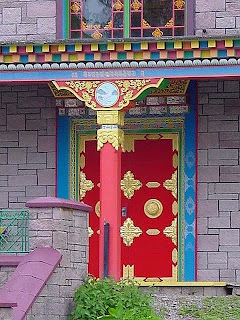Saturday, February 9, 2008
The Western Seaboard-Scotland 2007 (continuation No.19)
Posted by
Yates
at
1:05 PM
0
comments
![]()
The Western Seaboard-Scotland 2007 (continuation No.18)
Posted by
Yates
at
12:46 PM
0
comments
![]()
The Western Seaboard-Scotland 2007 (continuation No.17)
Posted by
Yates
at
12:04 PM
0
comments
![]()
Tibetan Buddhist Monastery
1967 - 2007
Located in a peaceful valley on the banks of the river Esk in Scotland, Kagyu Samye Ling was the first Tibetan Buddhist Centre to have been established in the West. It is a centre for wisdom and learning within the Karma Kagyu tradition of Tibetan Buddhism and is open to people of all faiths and none. You are welcome to come for day visits, short stays or to participate in our meditation retreats and courses available throughout the year.
Founded in 1967 and currently under the guidance of Abbot Lama Yeshe Losal Rinpoche, Samye Ling is part of Rokpa Trust, a registered charity which has three main areas of activity: spiritual, humanitarian aid, and Tibetan medicine and therapy. Our activity extends around the world through an international network of Dharma centres.
Posted by
Yates
at
3:46 AM
0
comments
![]()
Thursday, February 7, 2008
The Western Seaboard-Scotland 2007 (continuation No.16)
Posted by
Yates
at
1:56 PM
0
comments
![]()
The Western Seaboard-Scotland 2007 (continuation No.15)
Posted by
Yates
at
12:04 PM
0
comments
![]()
The Western Seaboard-Scotland 2007 (continuation No.14)
June 7 ~ The day started with very low cloud and fog, so went into Portree and visited Skye Crafts to select a cross-stitch map of Skye for Chenjie's mother, and then returned via the Staffin road to Columba 1400 to access the internet and check e-mails and send messages to family and dear friends abroad. By this time the fog was lifting so returned to Portree and onto to Armadale and the gardens at Armadale Castle. By this time the weather had turned very warm and sunny which showed the gardens at their best. Returned to the Ferry Inn at Uig via the west coast of Sleat through Tarskavaig, Tokavaig and Ord ~ stopping several times for photographs.
Posted by
Yates
at
11:47 AM
0
comments
![]()
Monday, February 4, 2008
Church of Saint John the Divine
From 1847 services were held in the National school in Horninglow village, licensed at the request of the incumbent of Holy Trinity, in Burton. There was an afternoon congregation of 60 adults on Census Sunday 1851, besides Sunday school children. A church, paid for mainly by voluntary subscriptions, was opened in 1866 and served a district chapelry within Holy Trinity ecclesiastical parish. The area covered Horninglow township except for the Wetmore area on the east side of the Birmingham-Derby railway line.
The bishop's consecration sentence gave the original dedication as St. John the Evangelist, but the present dedication to St. John the Divine was in use by 1911. The change was presumably made by Thomas Lewis during whose incumbency as vicar (1910-25) services became Anglo-Catholic in nature: he installed a rood screen as a memorial to the dead of the First World War, to which statues of the Virgin Mary and St. John were added in 1928.
The living, which was a vicarage, was initially worth £150 a year, rising to £290 by 1872, and the income came mainly from an endowment given by a local farmer, John Hopkins, and his brother-in-law William Hopkins of Dunstall Hall, in Tatenhill. William was named the patron, and he nominated his son-in-law, John Auden, as the first incumbent. On his death in 1873, William bequeathed the patronage to Auden, whose wife Sarah became the patron after her husband's death in 1876. After her death in 1925, the patronage was vested in trustees, still the patrons in association with the bishop in 1999.
No vicarage house was provided in the endowment, and the 'parsonage' that Auden occupied in 1868 was presumably the house in Horninglow later bequeathed to Sarah Auden by her father, William Hopkins. The present vicarage house was built in 1910 a short distance north of the church in Rolleston Road.
The National school in Horninglow Road North, west of the church, became a parish institute and reading room after it was replaced by a board school in 1876. A new room was added in 1887. The present parish room in Rolleston Road, built at the same time as the vicarage house in 1910. A church hall was opened in 1949 on a site to the north-east.
Church Building
The church was designed by Edward Holmes of Birmingham in a Geometrical style and consists of a chancel with north vestry, a nave of five bays, north and south aisles, and an engaged southwest tower with spire. It is built of brick faced externally with cream Coxbench stone and rendered internally with plaster and dressings of Bath stone. The nave arcades have octagonal piers with heavy, crocketed capitals and arches of blue York and red Alton stone in bands, and the high and wide chancel arch rests on corbels with short, detached stone shafts. The east window depicting the life of St. John the Evangelist is by William Warrington of London. The vestry was extended northwards in 1911, and in 1928 the east end of the south aisle was fitted out as a Lady chapel with a memorial window for Sarah Auden depicting St. Chad and St. Hilda with Celtic motifs. The font is at the west end. A peal of four steel bells was increased to six in 1875-6.
A burial ground beside the church was extended in 1898, 1911, and 1923.
From: 'Horninglow: Established church', A History of the County of Stafford: Volume 9: Burton-upon-Trent (2003), pp. 185-187. URL: http://www.british-history.ac.uk/report.aspx?compid=12359. - for information of Private & Personal use only
Posted by
Yates
at
7:08 AM
0
comments
![]()
Labels: Church of Saint John the Divine



















































